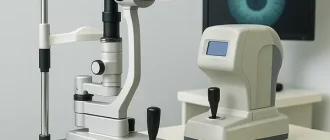Can Contact Lenses Cause Fungal Eye Infections? Yes, they can. While contact lenses are generally safe when used properly, improper care or extended wear can lead to serious complications, including fungal eye infections. Fungi, such as Fusarium, can invade the cornea, the clear outer layer of the eye, causing an infection known as fungal keratitis.
Effectiveness of Treatments for Fungal Keratitis
This horizontal bar chart illustrates the effectiveness of various treatments for fungal keratitis, with surgical options rated highest at 90% and oral medications at 70%. The data emphasizes the importance of choosing the appropriate treatment based on severity.
What Is Fungal Keratitis?
Fungal keratitis is a rare but serious eye condition. It occurs when fungal spores penetrate the cornea, often due to trauma or a breach in its surface. While it’s more common in tropical and subtropical climates, anyone who uses contact lenses or has a compromised immune system is at risk.
Symptoms of Fungal Eye Infections
Fungal eye infections often mimic other eye conditions, making diagnosis challenging. Key symptoms include:
- Redness and irritation in the eye: This symptom often feels like a persistent, burning sensation that doesn’t go away with rest or eye drops. It may worsen after wearing contact lenses.
- Eye pain that doesn’t improve: Pain can range from mild discomfort to sharp, stabbing sensations, particularly when moving the eye or blinking. Over-the-counter pain relievers typically have little to no effect.
- Blurred vision: You might notice a sudden drop in visual clarity, as if looking through foggy or dirty glasses. This blurring doesn’t resolve with blinking or cleaning your lenses.
- Sensitivity to light (photophobia): Bright lights, including sunlight or indoor lighting, may cause significant discomfort, forcing you to squint or close your eyes. This is often accompanied by headaches.
- Excessive tearing or discharge: Watery eyes or sticky discharge can make it difficult to keep your eyes open. The discharge may be clear, yellow, or green, depending on the severity of the infection.
- A white or gray spot on the cornea: Visible in the mirror or noticed by an eye doctor, this spot is a hallmark sign of fungal keratitis. It indicates the presence of fungal growth and requires immediate medical attention.
Symptoms of Fungal Eye Infections
| Symptom | Prevalence (%) |
|---|---|
| Redness and Irritation | 80% |
| Eye Pain | 70% |
| Blurred Vision | 65% |
| Sensitivity to Light | 60% |
| Excessive Tearing | 50% |
This table illustrates the prevalence of symptoms associated with fungal eye infections, highlighting redness and irritation as the most common (80%) and excessive tearing as less frequent (50%). Understanding these patterns can aid in early identification and treatment.
If you experience any of these symptoms, seek immediate medical attention. Delaying treatment can lead to severe complications, including vision loss.
Common Causes and Risk Factors
- Improper Lens Care: Using non-sterile solutions, reusing old solution, or wearing lenses longer than recommended increases the risk. For example, a 28-year-old office worker in Chicago reused her solution for weeks to save time and developed severe fungal keratitis, requiring months of treatment.
- Environmental Exposure: Swimming, showering, or using hot tubs while wearing lenses exposes your eyes to harmful fungi. A recreational swimmer in California faced a similar issue after wearing lenses in a public pool, highlighting the risks of water contamination.
- Trauma to the Eye: Any injury to the cornea can provide an entry point for fungal spores. For instance, a gardener in Texas sustained a minor scratch while pruning and developed an infection after handling plants and wearing lenses without proper hygiene.
- Immune System Issues: Conditions like diabetes or immunosuppressive therapy heighten the risk. A case study from New York showed that a patient with uncontrolled diabetes and poor lens care habits experienced a severe fungal infection that was challenging to treat.
Diagnosis and Treatment
Diagnosis
An ophthalmologist will perform a detailed examination of your eye using specialized tools such as a slit lamp, which allows close inspection of the cornea. If a fungal infection is suspected, they may take a corneal scraping to identify the specific fungal species under a microscope or through a culture test.
- Duration: The diagnostic process, including scraping and lab results, can take anywhere from a few hours to several days, depending on the complexity of the testing required.
- Cost: Diagnostic costs vary by location and healthcare provider but typically range from $150 to $500 for an office visit and basic lab tests. Advanced testing may increase this cost.
- Accessibility: While routine diagnostic tools are available at most eye care clinics, advanced fungal culture testing may require referral to a specialized laboratory, which could delay results.
- Expert Opinion: Dr. Michael Reyes, a corneal specialist, advises, “If you experience persistent eye symptoms, don’t wait. Prompt diagnosis is essential to prevent further damage to your vision.”
Treatment Options
- Antifungal Eye Drops: Medications such as natamycin are often prescribed.
- Duration: Typically, these drops are used for 4–6 weeks or longer, depending on the severity of the infection.
- Cost: A single bottle may range from $100 to $300 without insurance.
- Expert Opinion: Dr. Linda Martinez, an ophthalmologist, advises, “Consistency is key. Missing doses can prolong recovery or worsen the infection.”
- Oral Antifungal Medications: These may be necessary for severe infections.
- Duration: Treatment may last several weeks to a few months.
- Cost: Oral medications can cost $200–$500 per month depending on the drug and dosage.
- Expert Opinion: According to Dr. Charles Nguyen, “Combining oral and topical treatments often yields the best results, especially in stubborn cases.”
- Surgical Options: In extreme cases, corneal transplantation might be required to save vision.
- Duration: Recovery from surgery can take 6 months to a year.
- Cost: Surgery costs can range from $15,000 to $30,000, depending on the facility and complexity of the procedure.
- Expert Opinion: Dr. Emily Harper notes, “While surgery is a last resort, it can be life-changing for patients who’ve exhausted other options.”
Duration of Treatment for Fungal Keratitis
| Treatment Method | Duration (Weeks) |
|---|---|
| Antifungal Eye Drops | 4-6 weeks |
| Oral Antifungal Medications | 6-8 weeks |
| Surgical Recovery | 6-12 months |
This table highlights the typical duration of treatments for fungal keratitis, ranging from 4-6 weeks for antifungal eye drops to up to 12 months for surgical recovery. Knowing these timelines helps set realistic expectations for recovery.
Treatment for fungal keratitis can be lengthy, often taking weeks or months, depending on the severity.
Prevention Tips
- Practice Good Hygiene: Before handling contact lenses, wash your hands thoroughly with soap and water for at least 20 seconds. Dry them with a lint-free towel to prevent contaminants from transferring to your lenses.
- Follow Care Instructions: Always use fresh, sterile contact lens solution for cleaning and storing your lenses. Never use tap water or saliva. Clean your lens case every day with solution, let it air dry, and replace it every three months.
- Avoid Water Exposure: Remove your contact lenses before swimming, showering, or using a hot tub. If exposure is unavoidable, use waterproof goggles or switch to daily disposable lenses and discard them immediately afterward.
- Replace Lenses as Directed: Adhere strictly to the replacement schedule provided by your eye care professional. For example, if you’re using bi-weekly lenses, don’t stretch them to a month to save money—this increases the risk of infection.
- Regular Eye Exams: Schedule yearly check-ups with your eye doctor, or more frequently if you experience discomfort or redness. These exams can detect early signs of issues, including infections, before they worsen.
Prevention Practices and Adherence
| Prevention Practice | Adherence Rate (%) |
|---|---|
| Regular Lens Replacement | 70% |
| Using Fresh Solution | 60% |
| Avoiding Water Exposure | 50% |
| Cleaning Lens Case | 40% |
| Regular Eye Checkups | 30% |
This table shows the adherence rates for key prevention practices among contact lens users. Regular lens replacement has the highest adherence at 70%, while regular eye checkups remain the least followed practice at 30%, emphasizing the need for better awareness.
Real-Life Case Example: A Cautionary Tale
In Miami, a 32-year-old contact lens user developed fungal keratitis after wearing her lenses while swimming. Despite initial symptoms of redness and discomfort, she delayed seeking treatment, leading to severe corneal damage. Fortunately, with aggressive antifungal therapy and a corneal transplant, her vision was partially restored. This case underscores the importance of immediate medical attention and strict hygiene practices.
Editorial Advice
If you wear contact lenses, prioritize eye health by following proper hygiene and care practices. Early detection and treatment are key to preventing serious complications like fungal keratitis. Remember, your vision is invaluable—protect it with diligence and care.





